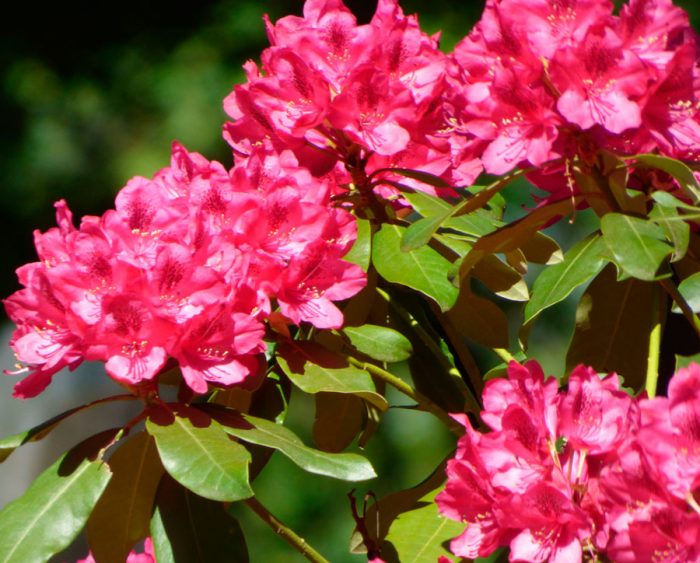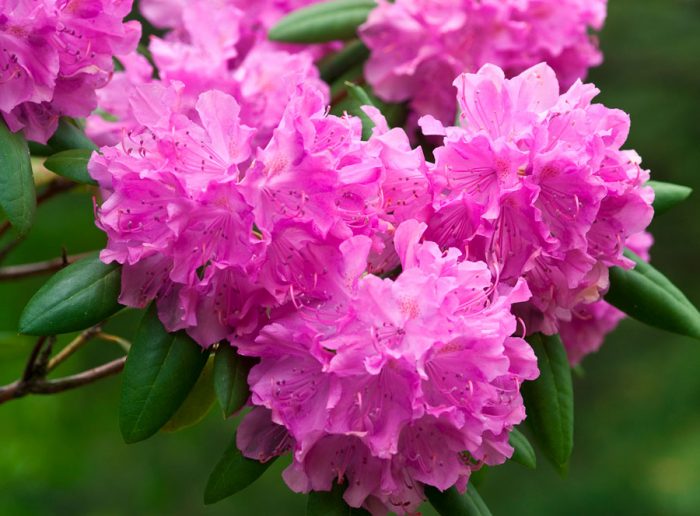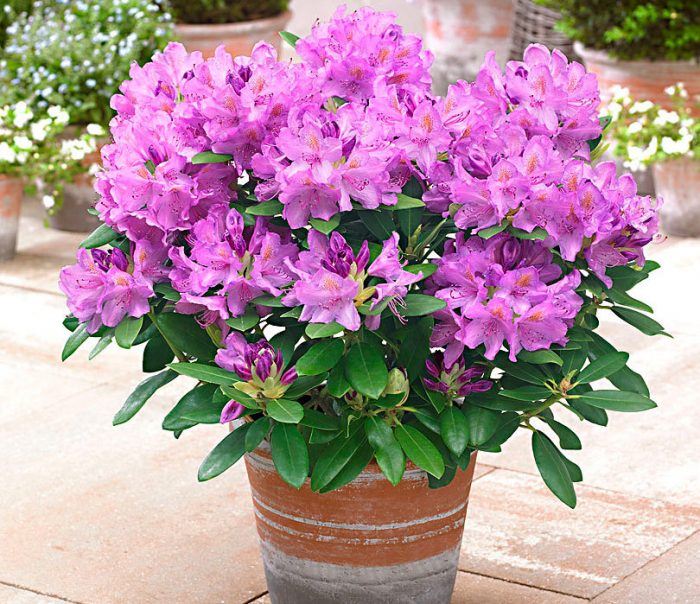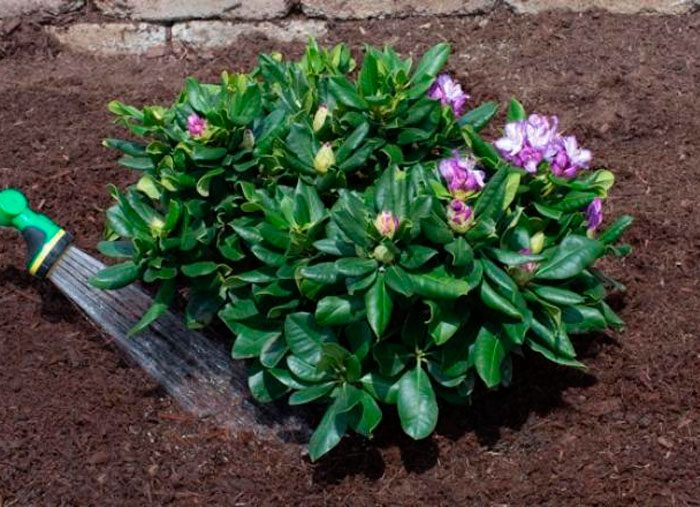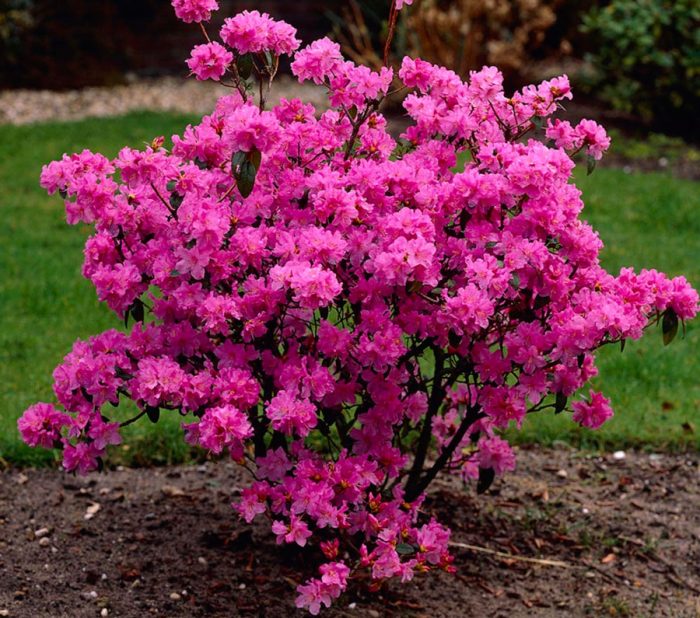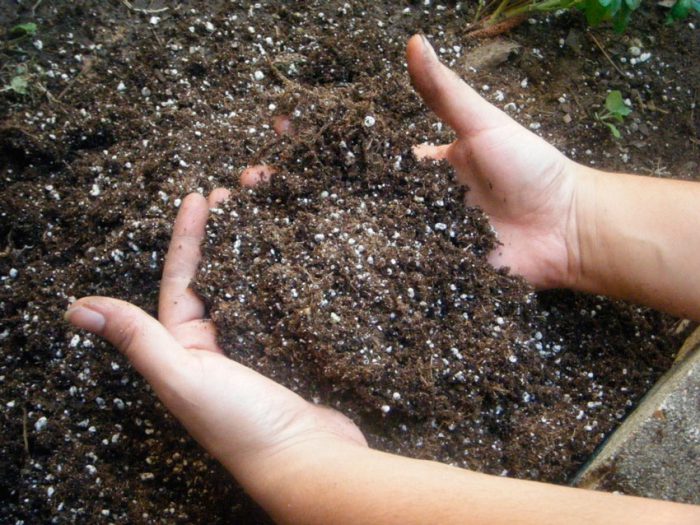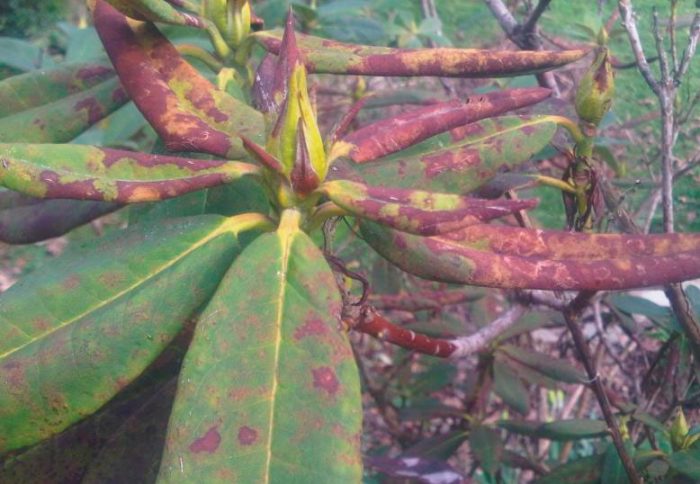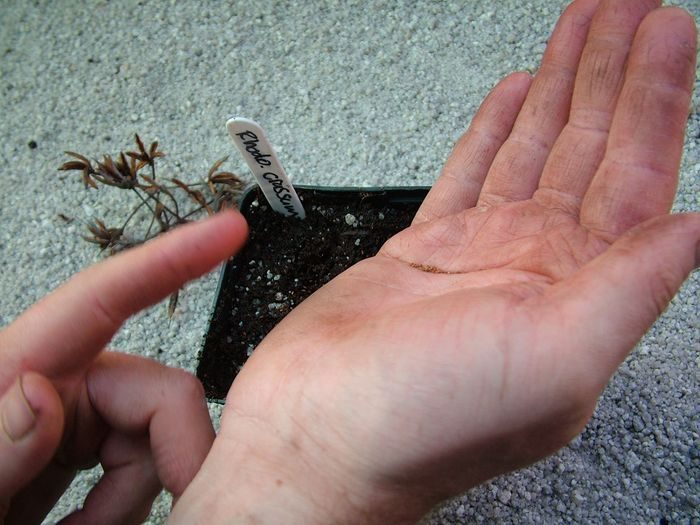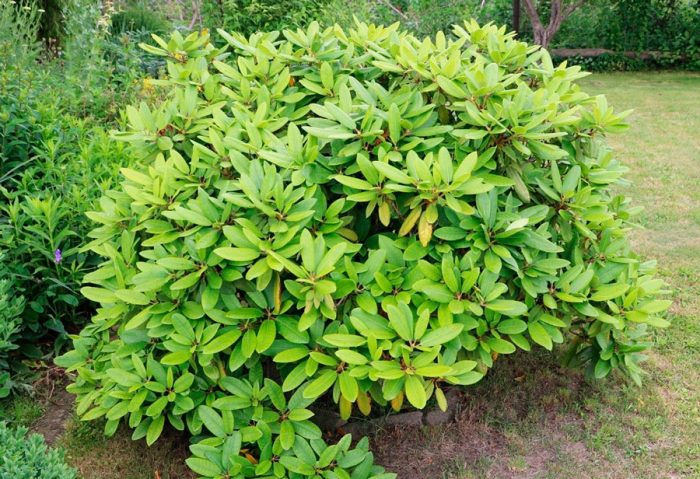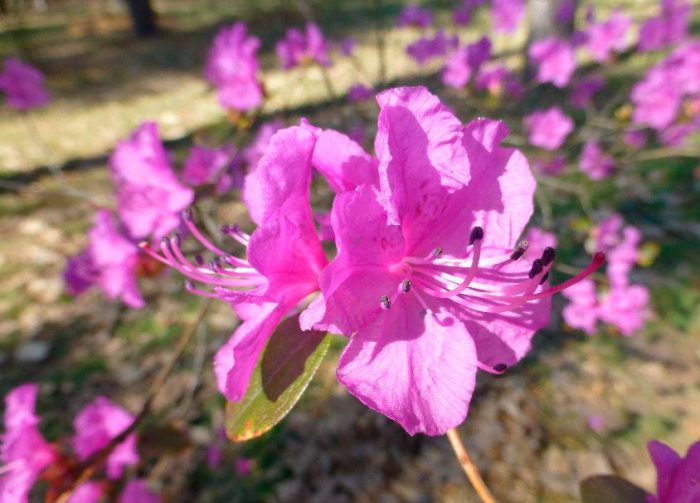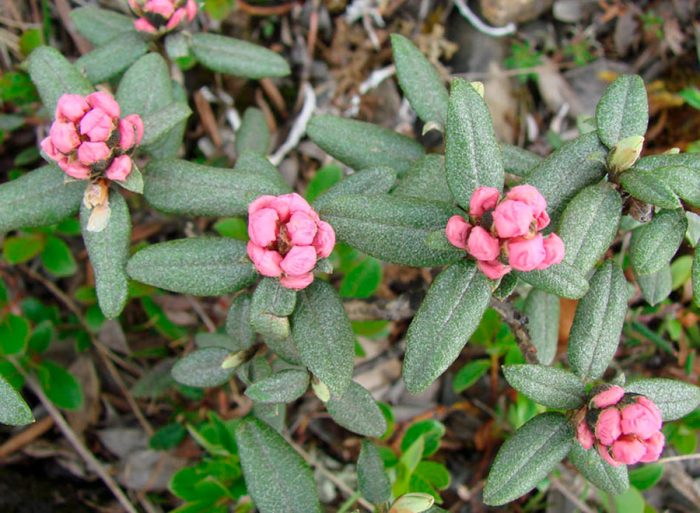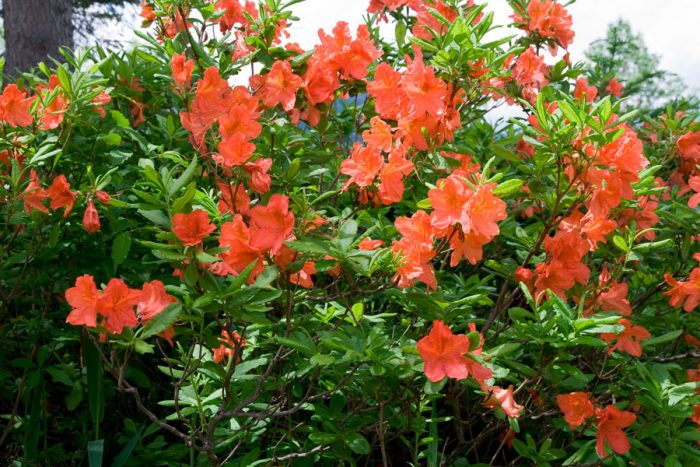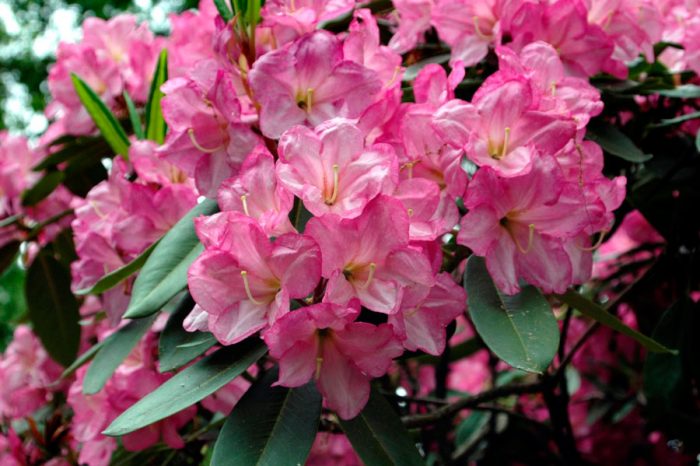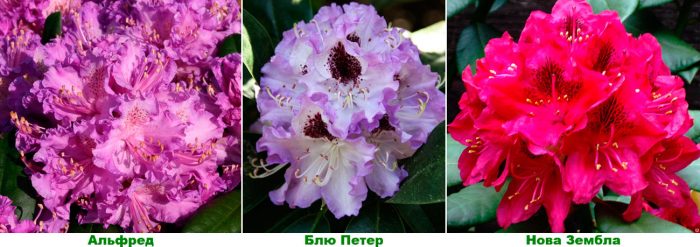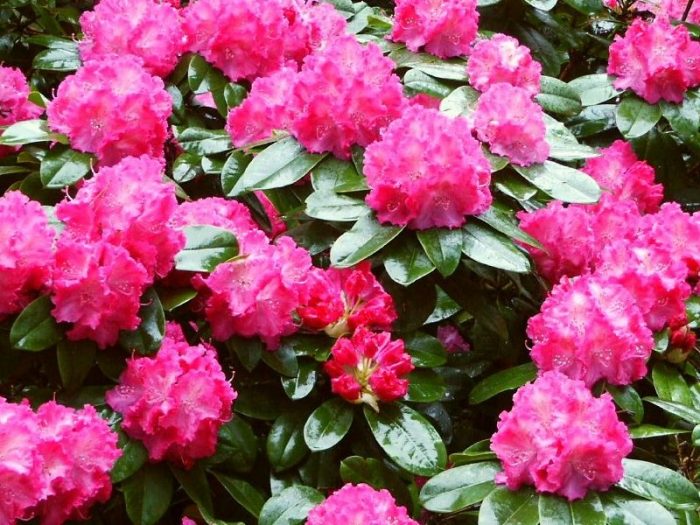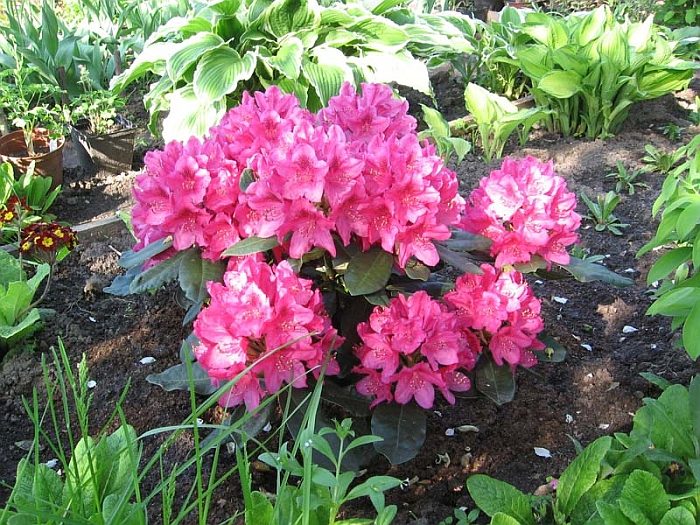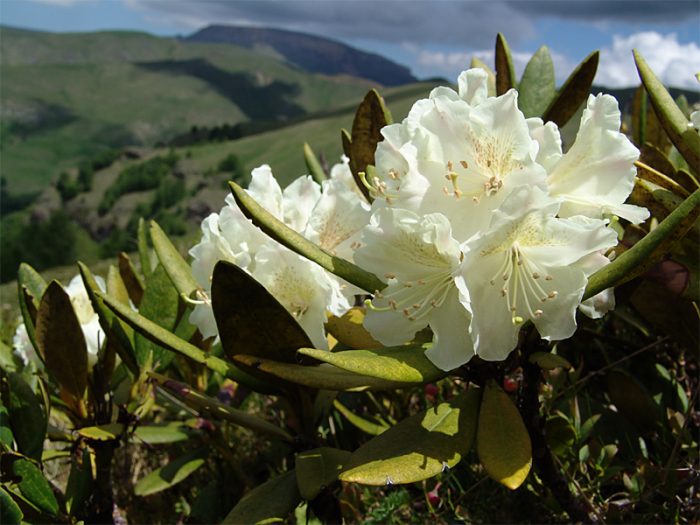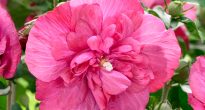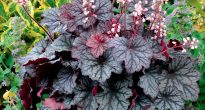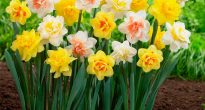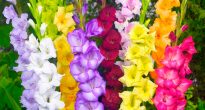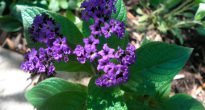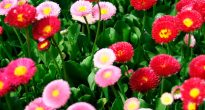Rhododendron (Rhododendron) is a member of the Heather family. This genus is represented by shrubs and trees, which are deciduous, semi-deciduous and evergreen. According to various sources, this genus unites 800-1300 species, including azaleas, which are very popular with flower growers, they are also called "indoor rhododendron". The name of this plant includes 2 words: "rhodon", which translates as "rose" and "dendron" - meaning "tree". In this regard, rhododendron means "tree with roses" or "rose tree". The fact is that azalea flowers are outwardly similar to roses. In the wild, rhododendrons are most widespread in the Northern Hemisphere (in southern China, the Himalayas, Southeast Asia, Japan and North America). They prefer to grow in the coastal zone of seas, rivers and oceans, on the northern slopes of mountains and in partial shade undergrowth. Some species reach a height of 0.3 m, while others are creeping shrubs. Flowers of various species of this genus differ from each other not only in color, but also in shape and size. For example, the largest flowers can be up to 0.2 m across, while the smallest are just tiny. Today, there are about 3 thousand varieties, forms and varieties of garden rhododendron.
Content
Features of rhododendron
The garden rhododendron is a shrub. Different species can differ from each other in the size and shape of the leaf plates, which are biennial, annual and perennial, petiolate or sessile, alternate, serrate or entire, obovate or ovate. This plant is relatively popular in all countries of the world due to its decorative foliage, as well as beautiful flowers that are part of racemose or corymbose inflorescences, which look like bouquets of amazing beauty. Flowers can be pink, purple, white, red or purple.The shape of the flowers directly depends on the type and variety of plants and can be funnel-shaped, tubular, bell-shaped or wheel-shaped. In some species, flowers have a pleasant smell. The fruit is a five-leafed polyspermous capsule with two-millimeter seeds inside. The superficial compact root system of this culture consists of a large number of fibrous roots. Due to the shallow root system, rhododendron transplanting is quite easy and the plant tolerates it well. This shrub is considered an excellent early spring honey plant.
Planting a rhododendron in open ground
Choosing the time and place of boarding
In middle latitudes, it is recommended to cultivate only those species of rhododendron that are highly frost-resistant. You can plant a plant in open soil from April to the second half of May, and also in September – November. Experienced gardeners are engaged in planting rhododendron throughout the growing season, with the exception of the flowering time of such a shrub, and this should not be done for 7-15 days after flowering.
For planting, you should choose a shaded area located on the north side of the building. The soil should be well-drained, loose, contain a large amount of humus and be acidic. If the groundwater depth on the site is less than 100 cm, then for planting this shrub you will have to make a raised bed. Rhododendron can be planted next to trees such as oak, pine, larch, as their root system goes deeper. This shrub is not recommended to be planted next to chestnut, maple, elm, linden, alder, willow and poplar, because their root systems are at the same depth as rhododendron, so the latter will lack the necessary amount of nutrients and moisture. If the rhododendron still has to be planted next to one of the listed trees, then the edges of the planting pit will need to be protected by digging slate, roofing material or polyethylene into the soil. The best neighbors for this crop are pear and apple trees.
Landing features
Prepare a hole for planting, so, its depth should be about 0.4 m, and its diameter should be about 0.6 m.Pour soil mixture into it, consisting of 3.5 buckets of loam (can be replaced with a pair of clay buckets), as well as 8 peat buckets. It should be mixed thoroughly. Then the soil mixture poured into the pit must be properly compacted. After that, a hole is made in it, the size of which should be equal to the size of the root ball of the planted plant. Immediately before planting, the seedling must be immersed in a container filled with water. And it is necessary to pull it out only after air bubbles stop coming out to the surface of the water. After that, the root system must be placed in a hole, which is filled with soil mixture, it must be compacted very well so that there are no voids. In a planted seedling, the root collar should be flush with the surface of the site. The planted plants need abundant watering. If the rhododendron was planted in dry soil, then the abundance of watering should be such that the earth is wet to a depth of 20 centimeters. Then the surface of the trunk circle should be covered with a layer of mulch (oak leaves, pine needles, peat or moss), while its thickness should be 50–60 mm. If the seedling has a large number of buds, then part must be cut off, in this case the forces of the plant will be directed to rooting, and not to lush flowering.
If only one rhododendron bush is planted in a spacious area, then the wind can shatter the seedling. To prevent this from happening, it is necessary to install a support, while tilting it towards the direction of the most often blowing winds. Then the planted plant is tied to the support. After the plant has taken root, the support can be removed if desired.


Watch this video on YouTube
Rhododendron care
Rhododendron needs good care. It must be sprayed, watered, fed, weeded, form-cut, and, if necessary, protected from pests and diseases if necessary. It is impossible to loosen or dig up the soil surface under the bushes due to the superficial location of the plant root system. Weeding must be done manually; it is strictly forbidden to use a hoe for this purpose.
The level of atmospheric and soil moisture is especially important for this crop compared to other garden plants, especially during budding and flowering. It is very important to water the rhododendron correctly, because this has a significant effect on the formation of flower buds of the next season. It is necessary to water the plant with extremely soft water (settled or rainwater). Some gardeners soften and acidify the water very simply, for this they mix it with high moor peat 24 hours before watering, you need to take a few handfuls. By the condition of the leaf plates, you can determine how often a given shrub should be watered. The plant needs watering if the foliage becomes dull and loses its turgor. During watering, the soil should be saturated to a depth of 20 to 30 centimeters. But when watering, it is also very important that liquid does not stagnate in the soil, since the root system reacts extremely negatively to this. With stagnant water, the rhododendron behaves in the same way as with a lack of moisture, namely, the leaf plates fold and fall. To avoid waterlogging, it is necessary to water the shrub during the dry hot period as usual, but it must be moistened quite often from a sprayer using soft water for this.
Pruning rhododendron
Since the bushes most often have a naturally correct shape, there is no need for strong formative pruning. As a rule, the plant needs pruning if the shrub becomes too tall, if rejuvenating pruning is needed, or if frost-damaged stems need to be cut.
What are the rules for pruning an adult shrub? Pruning of the stems is carried out in the spring, and you need to be in time before sap flow begins. Cuts on branches, the thickness of which is from 20 to 40 mm, must be coated with garden varnish. The awakening of dormant buds on the stems begins after 4 weeks, at the same time the beginning of the renewal process takes place, which lasts throughout the year. If the shrub is very badly damaged by frost or is old, then it should be shortened to 0.3-0.4 meters, while in the first year, one half of the bush is cut, and the next - the second.
These plants have one very important feature. So, in one year, their flowering and fruiting is distinguished by its abundance, while the next year, it bears fruit and blooms much poorer. However, this frequency can be corrected. To do this, after flowering is over, break off all faded inflorescences. In this case, the bush will send all the stored strength and nutrients to the laying of flower buds of the next season.
Feeding rhododendron
Even shrubs planted in the current season need feeding. The plant is fed for the first time in the season at the beginning of the spring period, while the last time is at the end of July, when the plant will bloom and young stems will begin to grow. Experts recommend using liquid fertilizers for feeding this crop, which should include horny flour and half-rotted cow dung. To prepare such a fertilizer, manure should be combined with water in a ratio of 1:15, then it should be infused for several days, only after that it can be fed to shrubs. Before feeding the rhododendron, it must be well watered.
Such plants need acidic soil, in this regard, mineral fertilizers should be chosen that do not disturb the reaction of the environment. So, it is recommended to use superphosphate, phosphate, nitrate and potassium sulfate, ammonium sulfate, calcium sulfate and magnesium, while taking them in a weak concentration (1.2: 1000). And the potassium fertilizer solution should be even weaker.
Recommended fertilization mode:
- at the beginning of spring, organic matter or mineral fertilizers containing nitrogen are applied, while 50 grams of magnesium sulfate and the same amount of ammonium sulfate are taken per 1 square meter of the plot;
- in the first days of June, when the plant will bloom, 20 grams of potassium sulfate and superphosphate, as well as 40 grams of ammonium sulfate, are added to 1 square meter of the plot;
- the third time the rhododendron is fed in July, while 20 grams of potassium sulfate and superphosphate are taken per 1 square meter of the plot.
Diseases and pests
Most often, mealybugs, scale insects, spider mites, bugs, weevils, rhododendron flies, as well as slugs and snails, settle on this shrub. When gastropods appear on the bushes, they should be collected manually, and for prophylactic purposes the plant is sprayed with a solution of the fungicidal preparation Tiram or TMTD (8%).
If rhododendron bugs, spider mites or weevils have settled on the rhododendron, then it must be sprayed with Diazinon. In this case, when weevils are affected, not only the bush is treated, but also the surface of the earth around it. In order to get rid of the rest of the pests, use Karbofos, while you need to follow the instructions given in the instructions.
Most often, such a plant suffers from fungal diseases, for example: cancer, rust, chlorosis, or leaf spot. Most often, such diseases develop as a result of insufficient aeration of the root system. If damaged by rust and spotting, the bush must be sprayed with copper-containing preparations, for example, Bordeaux mixture. In case of chlorosis, the bush changes its color to yellow, in this case, iron chelate must be added to the water for irrigation. If the rhododendron is sick with cancer, then it is necessary to either cut the affected stems to healthy tissue, or completely remove them. For prevention purposes, at the beginning of the spring and late autumn, the bushes should be sprayed with a Bordeaux mixture.
Reproduction of rhododendron
This plant can be propagated by seeds or by vegetative methods: layering, grafting, dividing the bush and grafting. The fastest and easiest way to propagate such a plant is by layering.
Seeds
For sowing seeds, bowls are used, which are filled with moistened peat or heather soil mixed with sand (3: 1). After the seeds are sown, they are sprinkled with sand on top, which must be washed. Cover the top of the container with glass, and then they are transferred to a well-lit place. Crops must be watered on time, ventilated every day, and condensate must be regularly removed from the glass surface. As a rule, the first seedlings appear after 30 days. When the seedlings have a pair of true leaf plates, they will need to be planted more freely using the 2x3 centimeters scheme. When transplanting, seedlings should be buried along the cotyledons, this will allow the formation of a strong root system. Seedlings in the first year of life must be grown in a cool greenhouse. In the second year, the seedlings should be transplanted into open soil on training beds with garden soil mixed with a small amount of peat and sand. Such seedlings are characterized by relatively slow growth. Their first flowering can be seen only at 6-8 years.
Cuttings
Cutting is also a rather complicated breeding method. For harvesting cuttings, semi-lignified stems are used. The length of the cuttings can vary from 50 to 80 mm. The lower leaf plates from the cut cuttings should be cut off.In this case, the lower sections must be immersed in a solution of an agent that stimulates root growth (for example, heteroauxin) for 12-16 hours. For rooting, the cuttings are planted in a substrate consisting of sand and peat (1: 3). Then cover the container on top with a transparent dome. Rooting cuttings is a long and difficult process. So, rooting of evergreen species lasts from 3 to 4.5 months, and deciduous - 6 weeks. For growing, cuttings are planted in boxes filled with a substrate consisting of pine needles and peat (1: 2). During the winter period, the cuttings should be kept in a well-lit and cool (8 to 12 degrees) room. With the onset of spring, the box with cuttings should be dug in the garden. There they will grow for another 1 or 2 years, only after that the cuttings can be transplanted to a permanent place.
Taps
The easiest and most natural method of propagation of this culture is by dropping layers. In spring, a low-growing young flexible shoot should be chosen, it must be bent and laid in a prepared groove, the depth of which should be at least 15 centimeters. The middle part of the stem must be fixed in the groove by pinning it. Next, the groove is filled with garden soil connected to peat. The top of the stem remaining on the surface must be tied to a vertically installed peg. When watering the bush itself, one should not forget to moisturize and layering. In autumn or with the onset of the next spring, the cuttings must be cut off from the parent plant and transplanted to a permanent place. This method is excellent for propagation of deciduous rhododendron.


Watch this video on YouTube
Rhododendron after flowering
Autumn care
If a drought is observed in the autumn, then the rhododendron will need regular abundant watering, so, under 1 bush, 10-12 liters of water should be poured. If in the autumn there are systematic rains, then watering such plants is not necessary. In November, the root system of the shrub should be insulated; for this, the surface of the trunk circle must be mulched with a layer of peat.
Wintering
If rhododendron is grown in middle latitudes, then after the first frost the bushes should be insulated. For this, branches of pine or spruce are pushed between the branches of the plant, and the shrub itself is slightly pulled together with twine. Then it should be covered with burlap. The bags should be removed from the plants in early spring after the snow cover has melted, and a cloudy day is chosen for this. If rhododendron is cultivated in a region with a sufficiently warm climate, then it does not need shelter for wintering.


Watch this video on YouTube
Types and varieties of rhododendrons with photos and names
There are a very large number of rhododendron species. Below will be described those species that are cultivated by gardeners, as well as the most popular garden varieties.
Rhododendron dahurian (Rhododendron dahuricum)
Under natural conditions, this species is found on the rocks and in the coniferous forests of Northeast China, Eastern Siberia, Primorsky Krai, Korea and Northern Mongolia. This medium-sized evergreen shrub is highly branching, its height can vary from 200 to 400 cm. The color of the bark is gray. The branches are directed upwards. Brownish-red thin shoots closer to the tips have pubescence, which is a short pile. The length of small leathery leaf plates is about 30 mm, their front surface is smooth, and the back is scaly. The color of young leaves is pale green, and over time they become dark green, in autumn they turn green-red or brown. In winter, only a small part of the foliage flies around. Flowering is quite lush and lasts about 20 days. The flowers bloom before the foliage opens. They are large, funnel-shaped, pink-purple in color, and reach 40 mm in diameter.In autumn, re-flowering is sometimes observed. This species is highly resistant to frost, and it also reproduces well with green cuttings. There are 2 types:
- evergreen form - the foliage is dark green, and the flowers are lilac-purple;
- early garden hybrid - this low-growing plant blooms very luxuriantly, the flowers reach 50 mm in diameter, they open very early and are painted in a rich red-blue color, this form is less frost-resistant compared to the main species.
Rhododendron adamsii
This evergreen shrub grows on rocky slopes and in the mountain forests of the Far East, as well as in the northeastern foothills of Tibet. The height of a branchy bush can reach up to 50 cm. On the surface of the shoots there is pubescence, consisting of a glandular pile. Matte dense green leaf plates have an oblong-elliptical shape in length and width, they can reach about 20 mm. Their front surface is naked, and there are scales on the seamy, which is why it has a red color. The scutes consist of 7-15 flowers, reaching 15 mm in diameter, they are colored in various shades of pink. This species is included in the Red Book of Buryatia.
Japanese Rhododendron (Rhododendron japonicum)
The homeland of this species is Japan, or rather, the island of Honshu, where it prefers to grow on sunny mountains. This species is one of the most beautiful deciduous rhododendrons. The height of a branchy shrub can reach 200 cm. The stems are bare or on their surface there are silver bristles. The green leaf plate has an oblong-lanceolate shape, both on the front and on the seamy surface there is a soft pubescence. In autumn, the foliage turns red-orange. Brushes consist of 6–12 bell-shaped fragrant flowers, reaching 80 mm in diameter and having a red-scarlet or orange color. Of all the species grown in mid-latitudes, this species is the most beautiful. It has a high frost resistance, and also perfectly reproduces by seed and cuttings.
Caucasian rhododendron (Rhododendron caucasicum)
In nature, this species is found in the Caucasus. This not very tall shrub is evergreen, its branches are creeping. Leathery dark green leafy plates, located on rather thick long petioles, have an oblong-oval shape. Their front surface is bare, and the seamy side is felt-red. On the hairy peduncles there are brushes consisting of 8-10 fragrant flowers with a funnel-bell-shaped shape and a pale green color, inside the throat there are green spots. Decorative forms:
- pink and white - flowering begins earlier than that of the main species;
- shiny - the color of the flowers is dark pink;
- golden yellow - there is a pale green speck on the surface of yellow flowers;
- straw yellow - light red spots are located on the surface of yellow flowers.
Also, gardeners cultivate such species as: Albrecht's rhododendron, Atlantic, Vaseya, holo-flowered, tree-like, yellow, coarse-haired, western, golden, Indian, Kamchatka, Canadian, Caroline, Carpathian, carpal, sticky, short-fruited, reddening, largest, large-leaved, , Lapland, Ledebura, small-leaved, marigold, sea buckthorn, pointed, dense, Pontic, attractive, Pukhan, rusty, equal, pink, Sikhotin, muddy, dull, rooting, Yakushiman, etc.
Hybrid rhododendron
This includes hybrids and variety forms that are cultivated by gardeners. The hybrid rhododendron is a garden rhododendron. The most popular varieties are:
- German cultivar Alfred... This variety was obtained by crossing the Ketevbinsky rhododendron with the Everestina variety. This evergreen shrub reaches a height of 1.2 m.The diameter of the crown is approximately 150 cm.Glossy dark green leaf plates have an oblong-elliptical shape. Dense inflorescences consist of 15–20 flowers of a rich purple color, which have a green-yellow spot, reaching 60 mm in diameter.
- Blue Peter variety... Was bred by crossing the Pontic rhododendron. The bush reaches more than 150 cm in height. The spreading crown has a diameter of about 200 cm. In diameter, the lavender-blue flowers reach 60 mm, they have a corrugated edge, and a speck of dark purple color is located on the upper petal.
- Jacksoni... This English hybrid was obtained by crossing the Caucasian rhododendron and the Nobleanum variety. The height of the shrub is about 200 cm, and its crown reaches about 300 cm in diameter. There is a low-growing form, the height of which does not exceed 0.8 m. Leathery leaf plates of an oblong shape have a green matte front surface and a brown one on the wrong side. The inflorescences consist of 8–12 flowers, which are painted pink during the opening process, then it changes to white, while a yellow-white speck forms on one of the petals.
- Rose Marie... Czech variety, which is obtained by crossing the magnificent rhododendron and Pink Pearl variety. The shrub reaches a height of 1.2 m, and the crown diameter is 150 cm. Leathery leaf plates have an oblong-elliptical shape, they have a waxy coating on the greenish front surface, and the back is green-blue, shiny. At the edges, the flowers are painted in a pale pink color, which by the middle is replaced by a deep pink with a purple tint. The compact spherical inflorescences consist of 6-14 flowers.
- Nova Zembla... This Dutch hybrid was bred by crossing the Katevbinsky rhododendron and the Persone Gloriosum variety. The height of the shrub is about 300 centimeters, and the loose crown in girth reaches about 350 cm. The stems grow almost vertically. Leathery glossy leaf plates are large enough. Dense inflorescences consist of 10-12 large flowers, up to 60 mm in diameter, they are colored red and have a black speck.
- Cunningham... This Scottish cultivar is a very popular variety of the Caucasian rhododendron. The height of the bush is about 200 cm, and the crown reaches 150 cm in diameter. The length of the dark green leathery oblong leaf plates is about 60 mm, and the width is 30 mm. Dense inflorescences consist of 10 white flowers, on the surface of which there is a yellow speck.


Watch this video on YouTube
Rhododendron in the Moscow region
Many non-professional gardeners, seeing a gorgeous rhododendron in the picture, decide by all means to decorate their garden plot with it. However, in most cases, having bought and planted the coveted bush on his plot, the gardener notices that his rhododendron is not as beautiful as expected, and besides, it is gradually withering away and dying. Therefore, most gardeners are wondering whether it is possible to successfully cultivate such a heat-loving shrub in the Moscow region? And in general, is it possible to grow such a plant in mid-latitudes that are unusual for it? If done correctly, then this is quite possible.
Features of landing in the Moscow region
The first thing to do is to choose the right variety that can survive the frosty winter months. The fact is that thermophilic species and varieties, even if they are very well covered, will still freeze in winter. Deciduous species are very suitable for growing in such conditions: Japanese, yellow, Schlippenbach, Vaseya, Canadian, Kamchatka, Pukhan rhododendron. From semi-evergreens, you can choose the Ledebour rhododendron. For growing in mid-latitudes from evergreen species, the Katevbinsky rhododendron is suitable (and also its hybrids Alfred, Abraham Lincoln, Nova Zembla, Cunningham White), also short-fruited, golden rhododendrons, the largest and Smirnov's rhododendron and his hybrids Gabriel, Dorothy Swift.Finnish breeders have recently obtained quite winter-hardy varieties Elvira, Hague, Mikkeli. The hybrids of the Northern Light group Rosie Lights, Pink Lights, Spicy Lights, etc. also tolerate the harsh winter of middle latitudes.
Landing rules
It is not enough to buy a suitable seedling, you still need to plant it correctly:
- Planting is done in the spring. The site should be in partial shade, and the distance between the seedling and any other plant should be at least 100 cm.
- For planting, it is recommended to buy a special soil mixture. If desired, it can be made at home, for this you need needles, garden soil and peat. Complex mineral fertilizer must be applied to the soil.
- The size of the planting hole should be a couple of times larger than the container in which the plant is located. If the soil is clay, then at the bottom of the hole you will need to make a good drainage layer of broken brick, the thickness of which should be about 15 centimeters.
- After planting, the root collar of the plant should be at the same level as in the container.
- The planted plant needs abundant watering.
Features of care in the Moscow region
Care for rhododendron cultivated in mid-latitudes should be almost the same as for those plants that are grown in regions with a milder climate. However, there are still a few differences. Care rules:
- For planting, you should use acidic humus soil. In those places from where the roots will absorb nutrients, there should be no wood ash, dolomite, lime and other additives that can alkalize the soil.
- The surface of the trunk circle must be covered with a layer of mulch without fail. This is especially important because due to the horizontally located roots, loosening and digging the soil near the plant is prohibited.
- In springtime, the shrub must be protected from the scorching rays of the sun. For this, gauze, mesh or fabric are suitable.
- It is very important to choose the correct watering regime. This plant should receive as much moisture as it needs. In the dry hot period in summer, the shrub must be watered 2 times every 7 days. If rainy and rather warm weather is observed in the autumn, then young shoots begin to grow in the bushes, but without ripening they die in winter. In order to prevent such an activation of stem growth, the bush should be treated with a solution of monophosphate or potassium sulfate (1%) from a fine atomizer and do it on a dry day. This will lead to a suspension of growth, as well as to the stimulation of lignification of the stems and the setting of flower buds for the next season. After the shrub is processed, all watering must be stopped, even if there is drought and heat.
- If you are worried that the bushes may be damaged by frost in winter, they should be covered. For this, a metal mesh frame is installed near the bush. It should be wrapped in spunbond, which is fixed with ropes.


Watch this video on YouTube
Useful properties of rhododendron
Rhododendron is a very beautiful plant, and it also has healing properties that have been used for more than one year in both official and non-traditional medicine. The composition of the species of rhododendron Daurian, golden, Adams, Caucasian includes andromedotoxin, ericolin, arbutin and rhododendrin. The foliage contains ascorbic acid, while in summer its concentration in the plant is highest. Thanks to the substances included in the composition of such a plant, it has an analgesic, sedative, antipyretic, antibacterial and diaphoretic effect. It is also able to remove excess fluid from the body, eliminate swelling, shortness of breath, rapid heartbeat, enhance cardiac activity, and also reduce venous and blood pressure.
But you should not assume that this plant is absolutely harmless. Products made on the basis of rhododendron should not be used by people suffering from serious kidney disease and tissue necrosis, as well as by pregnant and breastfeeding women.It is also recommended that you consult with a specialist before taking such a remedy for the first time.

